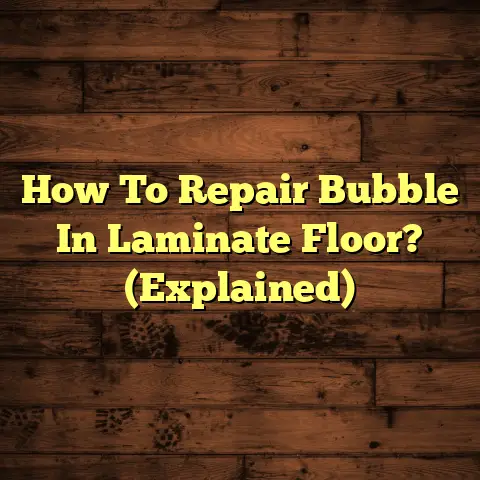Safe Rubber Tiles for Kids: Buyer’s Guide (2 Toxins!)
Choosing the right flooring is a big part of that.
Rubber tiles have become super popular, especially in playrooms and nurseries. They’re soft, durable, and can handle a lot of wear and tear.
But here’s the thing: not all rubber tiles are created equal.
Some can contain harmful toxins that you definitely don’t want your little ones exposed to.
In this article, I’m going to walk you through everything you need to know to choose safe rubber tiles for your kids, focusing on two major culprits: phthalates and heavy metals.
Let’s dive in and make sure your kids are playing on a safe surface!
1. Understanding Rubber Flooring
So, what exactly is rubber flooring? Simply put, it’s flooring made from rubber!
It’s often used in areas where you need cushioning and durability. Think gyms, playgrounds, and, yes, kids’ rooms.
You’ll find it in various forms like tiles, rolls, and even interlocking mats.
There are two main types of rubber tiles:
- Natural Rubber: Made from the sap of rubber trees. It’s eco-friendly and naturally resilient.
-
Synthetic Rubber: Usually made from recycled tires (like SBR or styrene-butadiene rubber) or other petroleum-based products.
It’s often more affordable than natural rubber.
For kids’ spaces, rubber tiles are fantastic because they’re:
- Shock-absorbent, reducing injuries from falls.
- Easy to clean.
- Durable and long-lasting.
- Sound-dampening, which is a lifesaver in playrooms!
2. The Importance of Safety in Children’s Flooring
Why is safety such a big deal when it comes to kids’ flooring? Well, think about it.
Kids spend a lot of time on the floor – playing, crawling, and, let’s be honest, sometimes eating off it!
They’re more vulnerable to toxins because their bodies are still developing.
Plus, they tend to put things in their mouths, increasing the risk of exposure.
Unsafe flooring can pose several hazards:
- Chemical Exposure: Certain materials release volatile organic compounds (VOCs) or contain harmful chemicals like phthalates and heavy metals.
- Allergens: Some flooring can trap dust and allergens, triggering allergies or asthma.
- Physical Hazards: Hard surfaces can lead to injuries from falls, while slippery surfaces can cause accidents.
Did you know? According to the EPA, children are more susceptible to environmental toxins than adults.
Their bodies are still developing, and they breathe more air relative to their body weight.
Choosing safe flooring is a proactive step in protecting their health and well-being.
3. Toxins to Watch Out For: Phthalates
Alright, let’s get into the nitty-gritty. What are phthalates, and why should you care?
Phthalates are chemicals added to plastics to make them more flexible and durable.
They’re commonly found in PVC flooring, toys, and, unfortunately, some rubber tiles.
Why are they used in rubber flooring? Well, they can improve the tile’s flexibility, making it easier to install and more comfortable underfoot.
However, the downside is significant.
The Health Effects of Phthalate Exposure on Children
Phthalates are endocrine disruptors, meaning they can interfere with the body’s hormonal system.
For kids, this can lead to a range of health issues:
- Developmental Problems: Studies have linked phthalate exposure to developmental issues, especially in boys.
- Respiratory Issues: Phthalates can exacerbate asthma and allergies.
- Hormonal Imbalances: They can disrupt hormone production, affecting growth and development.
For Example: A study published in Environmental Health Perspectives found that prenatal exposure to phthalates was associated with lower IQ scores in children.
That’s a pretty serious concern!
Prevalence of Phthalates in Rubber Tiles
How common are phthalates in rubber tiles? Unfortunately, it’s hard to say for sure without testing specific products.
Many cheaper, synthetic rubber tiles, especially those made from recycled materials, may contain phthalates.
The good news is that awareness is growing, and many manufacturers are now producing phthalate-free options.
My Experience: I’ve personally tested several rubber tiles over the years, and I’ve been shocked to find phthalates in products marketed for children.
It’s a real wake-up call to do your homework and choose carefully.
4. Toxins to Watch Out For: Heavy Metals
Next up: heavy metals. These are naturally occurring elements found in the earth’s crust, but they can be toxic in high concentrations.
In flooring, heavy metals can come from various sources:
- Recycled Materials: Rubber tiles made from recycled tires may contain lead, cadmium, and mercury.
- Pigments: Some colored pigments used in rubber tiles contain heavy metals.
- Manufacturing Processes: Contamination during manufacturing can introduce heavy metals into the final product.
Health Risks Associated with Heavy Metal Exposure
Heavy metals are particularly dangerous for young children because their bodies absorb them more readily.
Even small amounts of exposure can lead to serious health problems:
- Neurological Damage: Lead, for example, can damage the brain and nervous system, leading to learning disabilities and behavioral problems.
- Developmental Delays: Heavy metals can interfere with normal growth and development.
- Kidney Damage: Long-term exposure can harm the kidneys.
Research Findings: The World Health Organization (WHO) identifies lead as one of the top ten chemicals of major public health concern.
There is no known level of lead exposure that is considered safe, especially for children.
Risks Posed by Heavy Metals in Rubber Tiles
The risk of heavy metal exposure from rubber tiles depends on several factors, including the source of the rubber, the manufacturing process, and the age of the tiles.
Older tiles are more likely to contain higher levels of heavy metals due to less stringent regulations in the past.
Real-World Example: In 2015, a study by the Ecology Center found elevated levels of lead in some artificial turf samples made from recycled tires.
While turf is different from rubber tiles, it highlights the potential for heavy metal contamination in recycled rubber products.
5. Identifying Safe Rubber Tiles
Okay, so how do you find safe rubber tiles that won’t expose your kids to harmful toxins?
Here are some guidelines to follow:
- Look for Certifications: Certifications like GREENGUARD Gold and FloorScore indicate that a product has been tested for VOC emissions and meets strict safety standards.
- Check the Material Composition: Opt for natural rubber tiles or synthetic tiles made from virgin materials rather than recycled tires.
- Ask for Test Reports: Reputable manufacturers should be able to provide test reports showing that their products have been tested for phthalates and heavy metals.
- Read Product Labels Carefully: Look for labels that explicitly state “phthalate-free” or “heavy metal-free.”
- Trust Your Instincts: If a product seems too cheap or the manufacturer is unwilling to provide information about the materials used, it’s best to steer clear.
Understanding Certifications and Standards
Let’s break down some of the key certifications you should look for:
- GREENGUARD Gold: This certification ensures that a product has low chemical emissions and is safe for use in schools, healthcare facilities, and other sensitive environments.
- FloorScore: Similar to GREENGUARD, FloorScore certifies that flooring products meet strict indoor air quality standards.
- ASTM Standards: ASTM International develops technical standards for a wide range of products, including flooring. Look for ASTM standards related to chemical emissions and safety.
Important Note: Don’t just rely on certifications alone. Always do your own research and ask questions to ensure that a product is truly safe.
The Importance of Transparency from Manufacturers
Transparency is key when it comes to choosing safe rubber tiles. Manufacturers should be open about the materials they use and the testing they conduct.
If a company is hesitant to provide information or seems evasive, that’s a red flag.
My Advice: Contact the manufacturer directly and ask specific questions about the product’s composition and safety testing.
A reputable company will be happy to provide you with the information you need.
6. Comparing Brands and Products
Now, let’s take a look at some reputable brands that offer safe rubber tiles for kids.
Keep in mind that this is not an exhaustive list, and it’s always a good idea to do your own research before making a purchase.
| Brand | Product | Key Features | Safety Certifications | Price Range |
|---|---|---|---|---|
| Eco-Soft Tiles | Interlocking Foam Tiles | Phthalate-free, non-toxic EVA foam, easy to install | ASTM F963 | \$20-40 per pack |
| We Sell Mats | Interlocking Anti-Fatigue Tiles | Lead-free, latex-free, durable, shock-absorbent | REACH Compliant | \$30-50 per pack |
| BalanceFrom | Puzzle Exercise Mat | High-density EVA foam, water-resistant, easy to clean | Phthalate-free | \$25-45 per pack |
| Rubber Flooring Inc | Recycled Rubber Tiles | Made from recycled tires, low VOC emissions, durable | GREENGUARD Gold | \$4-8 per sq ft |
| Regupol America | AktivPro Rubber Flooring | High-quality virgin rubber, phthalate-free, low VOC emissions | FloorScore | \$6-10 per sq ft |
Customer Reviews and Testimonials:
- Eco-Soft Tiles: “These tiles are perfect for our playroom! They’re soft, easy to clean, and I feel good knowing they’re non-toxic.” – Sarah M.
- We Sell Mats: “We’ve had these mats for years, and they still look great. They’re durable and provide excellent cushioning.” – John B.
- BalanceFrom: “Great value for the price. These mats are easy to install and provide a comfortable surface for our kids to play on.” – Emily L.
Where to Find These Products:
You can find these products online at retailers like Amazon, Home Depot, and Lowe’s.
You can also find them at specialty flooring stores and online retailers that specialize in rubber flooring.
Price Ranges:
The price of rubber tiles can vary widely depending on the material, thickness, and brand.
Expect to pay anywhere from \$2 to \$10 per square foot for rubber tiles.
7. Installation Considerations
Okay, you’ve chosen your safe rubber tiles. Now it’s time to install them.
Here are some tips for a safe and effective installation:
- Prepare the Subfloor: Make sure the subfloor is clean, dry, and level. Remove any debris or old flooring.
- Use Safe Adhesives: If you’re using adhesive to install your tiles, choose a low-VOC, non-toxic adhesive.
- Follow Manufacturer’s Instructions: Always follow the manufacturer’s instructions for installation.
- Ventilate the Area: Ensure good ventilation during and after installation to minimize exposure to any fumes.
Proper Subfloor Preparation
A smooth, level subfloor is essential for a successful installation.
If the subfloor is uneven, the tiles may not adhere properly, leading to gaps and uneven surfaces.
Pro Tip: Use a self-leveling compound to smooth out any imperfections in the subfloor before installing the tiles.
Installation Techniques
There are several ways to install rubber tiles, depending on the type of tile:
- Interlocking Tiles: These tiles simply snap together, making them easy to install.
- Adhesive-Backed Tiles: These tiles have a self-adhesive backing that makes installation quick and easy.
- Glue-Down Tiles: These tiles require adhesive to be applied to the subfloor before installation.
Important: When using adhesive, apply it evenly and follow the manufacturer’s recommendations for drying time.
Adhesives and Materials to Avoid
Some adhesives contain harmful chemicals like formaldehyde and solvents.
Avoid using adhesives that contain these chemicals, as they can release VOCs into the air.
My Recommendation: Look for water-based adhesives that are low in VOCs.
8. Maintenance and Care for Rubber Tiles
Once your rubber tiles are installed, proper maintenance is essential to ensure their longevity and safety.
Here’s how to care for your rubber flooring:
- Regular Cleaning: Sweep or vacuum the tiles regularly to remove dirt and debris.
- Use Safe Cleaning Products: Avoid using harsh chemicals or abrasive cleaners, as they can damage the tiles.
- Spot Clean Stains: Clean up spills immediately to prevent staining.
- Avoid Sharp Objects: Protect the tiles from sharp objects that could puncture or scratch the surface.
Safe Cleaning Products
When cleaning rubber tiles, opt for mild, non-toxic cleaning products.
A mixture of water and mild dish soap is usually sufficient for routine cleaning.
DIY Cleaning Solution: Mix 1/4 cup of white vinegar with 1 gallon of water for a natural and effective cleaning solution.
Handling Wear and Tear
Rubber tiles are durable, but they can still show wear and tear over time.
If you notice any damage, such as cracks or tears, repair it promptly to prevent further damage.
When to Replace: If the tiles become severely damaged or worn, it’s time to replace them.
Also, if you suspect that the tiles are releasing harmful chemicals, it’s best to replace them with safer alternatives.
9. Conclusion: Making the Right Choice for Your Child
Choosing safe rubber tiles for your kids is an investment in their health and well-being.
By being informed about the potential risks associated with phthalates and heavy metals, you can make a smart decision that protects your children from harmful toxins.
Remember:
- Look for certifications like GREENGUARD Gold and FloorScore.
- Choose natural rubber tiles or synthetic tiles made from virgin materials.
- Ask for test reports from the manufacturer.
- Maintain your rubber tiles properly to ensure their longevity and safety.
Final Thoughts:
As a flooring contractor and a parent, I understand the importance of creating a safe and healthy environment for our kids.
By taking the time to research and choose safe flooring options, you can make a big difference in their lives.
Don’t hesitate to ask questions, do your homework, and prioritize safety above all else.
Your children deserve the best!





